Imagine running a restaurant where every customer feels like a VIP, orders flow seamlessly, and profits keep sizzling like a perfect dish. That’s the power of a restaurant app!
In a world where convenience reigns supreme, having a custom app isn’t just a trend; it’s a necessity. From effortless reservations to one-click food deliveries, these apps redefine how restaurants connect with diners.
But before you dive into the digital world, there’s one burning question: how much does it cost to develop a restaurant app? Let’s explore how these apps can revolutionize your business and what it takes to make it happen.
Understanding Restaurant Apps
A restaurant app is a custom-built mobile application that is designed to enhance the dining experience by providing convenient features for both customers and businesses.
It typically includes menu browsing, order customization, online payments, and delivery tracking, all in one place. Customers can easily explore menu items, personalize their orders, pay securely, and track deliveries in real-time.
Benefits of Developing a Restaurant App:
-
- Enhanced Customer Experience: With seamless browsing, ordering, and payment features, customers enjoy a hassle-free experience.
- Operational Efficiency: Businesses can streamline their operations by automating tasks like order taking and payment processing.
- Improved Customer Insights: Apps provide valuable data on customer preferences and behavior, allowing restaurants to tailor their offerings.
- Increased Revenue: Offering delivery and online ordering boosts sales by reaching a wider audience.
- Competitive Edge: A well-designed app sets a restaurant apart in the competitive food industry, attracting more customers.
Why Developing a Restaurant App is Beneficial in 2025?
Driven by increased reliance on technology and convenience, the need for restaurant applications is expanding as we go toward 2025.
Nowadays, consumers seek speedy, seamless experiences while dining out or ordering, so developing a restaurant app is a must-have tool for companies striving to maintain competitiveness.
1. Growing Popularity of Restaurant Apps
The rise of mobile-first consumers has altered how individuals interact with eateries. Apps allow consumers to explore menus, place orders, and make payments in just a few touches, delivering unrivaled simplicity.
As digital solutions become more integrated into everyday life, the popularity of restaurant applications is predicted to continue expanding.
2. Market Demand for Restaurant Apps
The growth in meal delivery services and shifting consumer behaviors have driven the demand for restaurant apps. A 2023 survey indicated that 60% of people prefer ordering food via a smartphone app rather than calling or dining in. {Restaurant Technology News}
With meal delivery services anticipated to rise by 10% yearly through 2025, restaurant apps are vital for businesses trying to meet this demand. The global market for restaurant technology is estimated to reach $35 billion by 2025, underscoring the vital role apps play in consumer engagement and loyalty.
Here are some key statistics highlighting the growing demand for restaurant apps:
-
-
Increased Food Delivery App Usage: As of March 2021, 47% of Americans had used a food delivery app, up from 38% in March 2020, illustrating significant growth in the sector. {Hotel Tech Report}
-
Preference for Restaurant-Specific Ordering: 71% of consumers prefer ordering through a restaurant's own website or mobile app over third-party platforms, valuing lower costs and convenience. {Restaurant Technology News}
-
Projected Growth in the Restaurant Technology Market: The global restaurant software market is forecast to reach $6.6 billion in 2024, with a 16.5% compound annual growth rate through 2033. {HL}
-
These statistics underscore the increasing reliance on mobile apps for food ordering and the substantial market growth, highlighting the importance for restaurants to invest in app development to meet consumer expectations and stay competitive.
3. Improved Customer Engagement and Loyalty
Restaurant applications enable businesses to engage customers with loyalty programs, customized promotions, and push notifications. Offering rewards and discounts for repeat orders can help boost client retention and create long-term connections.
Additionally, the software allows restaurants to track client preferences, enabling tailored experiences that enhance satisfaction.
4. Operational Efficiency and Data Insights
Restaurant apps enhance ordering, payment, and delivery processes, boosting operational efficiency. This decreases wait times, errors, and management complexity.
Furthermore, applications provide essential user data that allows businesses to optimize menus, estimate demand, and eliminate waste, leading to cost savings and higher profitability.
Investing in a restaurant app helps businesses stay competitive, engage consumers, streamline operations, and drive development.
Essential Features of a Restaurant App
A well-designed restaurant app is highly important for creating a seamless and efficient client experience. To stay competitive in today’s digital world, restaurants must use and integrate high-tech features that promote convenience, engagement, and operational efficiency to the users.
Below are the fundamental characteristics that should be included in a restaurant app, and understanding these aspects is important when determining the cost to build a restaurant app.
1] Menu Browsing and Customization
A clear, user-friendly menu display is vital for any restaurant app. Customers should be able to explore food and drink selections, examine full descriptions, and check ingredient lists.
-
-
The option to personalize orders, such as adjusting portion sizes or deleting items, is essential.
-
This feature adds to the cost to make a restaurant app, especially if the menu includes significant customization choices.
-
2] Online Ordering and Payment
An integrated Internet ordering system is vital for restaurants, especially those offering takeout or delivery services. Customers should place orders promptly and securely through numerous payment methods.
The cost of developing a restaurant app increases when integrating several payment gateways, including credit cards, digital wallets, and contactless payment.
3] Delivery Tracking
Real-time delivery monitoring promotes customer satisfaction by allowing consumers to follow their orders from kitchen preparation to doorstep arrival. Integrating GPS tracking elements into the app can add to the cost to build a restaurant app, but it dramatically boosts user experience and reliability.
4] Loyalty and Rewards Program
A loyalty program within the app might track customer points or offer rewards. It stimulates repeat business and fosters client loyalty. This feature can boost restaurant app prices depending on how intricate the reward system is.
5] Reviews and Ratings
Allowing clients to offer feedback through reviews and ratings helps enhance services and menu items. While this feature is vital for client engagement, it adds to the cost of developing a restaurant app as it requires backend support and moderation.
6] Push Notifications
Push alerts to keep clients updated about special discounts, new menu items, or loyalty benefits. By sending targeted notifications, restaurants can increase repeat visits. This function is often featured in most apps, although customization may affect the restaurant app guidance.
Including these capabilities in your restaurant app offers a full, engaging experience for users while improving operational efficiencies. While these capabilities can increase the cost to develop a restaurant app, they are vital expenditures for restaurants wanting to remain competitive in a tech-driven environment.
How Much Does it Cost to Create a Restaurant App?
If you're asking, 'How much does it cost to create a restaurant app?'
The cost to make a restaurant app can go from $30,000 to $150,000+ based on features, complexity, and design.
For further details, check out the table below, which provides a comprehensive overview of the costs based on different levels of complexity and features.
|
App Complexity |
Basic App |
Medium App |
Advanced App |
|
UI/UX Design |
$5,000 - $10,000 |
$10,000 - $15,000 |
$15,000 - $25,000 |
|
User App Features |
$10,000 - $12,000 |
$12,000 - $25,000 |
$25,000 - $40,000 |
|
Admin Panel |
$5,000 - $7,000 |
$7,000 - $15,000 |
$15,000 - $30,000 |
|
Ordering System |
$6,000 - $8,000 |
$8,000 - $15,000 |
$15,000 - $25,000 |
|
Backend Development |
$15,000 - $25,000 |
$25,000 - $40,000 |
$40,000 - $60,000 |
|
Payment Gateway |
$3,000 - $5,000 |
$5,000 - $10,000 |
$10,000 - $15,000 |
|
AI Integration |
- |
$8,000 - $15,000 |
$25,000 - $40,000 |
|
Total Estimate |
$30,000 - $60,000 |
$60,000 - $100,000 |
$150,000 + |
While the costs shown in the table are based on average industry estimates, to gain a deeper understanding of the development process, consider this complete breakdown of the costs involved in building a restaurant app.
Cost Breakdown of Developing a Restaurant App
Developing a restaurant app involves various factors that determine the cost to build a restaurant app.
The cost can vary based on features, complexity, platform choice, and design. In this detailed breakdown, we will explore the primary elements that influence the cost to develop a restaurant app and provide a guide to understanding these costs.
1. Platform Choice: iOS, Android, or Both
The platform you choose for your restaurant app significantly impacts the overall development cost. Whether you opt for iOS, Android, or both platforms, each comes with its own set of requirements.
-
-
iOS Development: iOS apps tend to be slightly more expensive to develop due to Apple’s strict guidelines and the need to hire iOS app developers.
-
Android Development: Android apps generally take longer to develop because of the variety of devices and screen sizes.
-
Both Platforms: Developing for both platforms can double the development cost but ensures you reach a larger audience.
-
|
Platform |
Cost Range |
Pros |
Cons |
|
iOS |
$15,000 - $50,000 |
High user engagement, uniform devices |
Limited to Apple users |
|
Android |
$20,000 - $60,000 |
More market share, customization options |
Longer development time |
|
Both |
$35,000 - $100,000 |
Larger audience reach |
Double development cost |
2. Features and Functionality
The complexity and variety of features included in your restaurant app will directly impact the restaurant app development cost. Below is a breakdown of key features and their typical costs.
|
Feature |
Cost Range |
Description |
|
Menu Browsing |
$2,000 - $5,000 |
Basic menu with images and descriptions |
|
Online Ordering System |
$4,000 - $10,000 |
Integration of order and payment system |
|
Customization Options |
$2,500 - $7,500 |
Allow customers to customize their orders |
|
Delivery Tracking |
$3,000 - $7,000 |
GPS integration for real-time tracking |
|
Loyalty Program |
$2,000 - $6,000 |
Rewards and points system |
|
Push Notifications |
$1,000 - $3,000 |
Notifications for offers and promotions |
|
Customer Reviews |
$1,500 - $4,000 |
Ratings and feedback system |
|
Social Media Integration |
$1,500 - $4,500 |
Sharing, sign-in, or social media promotions |
3. Design and User Experience (UX/UI)
A good design is crucial to the success of any restaurant app. The cost to build a restaurant app can increase depending on the complexity of the design and the user experience.
Simple, templated designs are cheaper, while custom, highly interactive designs require more resources.
|
Design Type |
Cost Range |
Description |
|
Template Design |
$3,000 - $7,000 |
Pre-built templates for faster deployment |
|
Custom Design |
$7,000 - $20,000 |
Unique, custom designs tailored to your brand |
|
Hybrid Design |
$5,000 - $12,000 |
Combination of templates and custom elements for flexibility |
|
Premium Design |
$15,000 - $30,000 |
High-end design with advanced features, animations, and exclusive branding elements |
|
Minimalist Design |
$4,000 - $8,000 |
Simple, sleek designs focusing on essential features and functionality |
4. Backend Development
The backend of your restaurant app is crucial for managing orders, payments, customer data, and more. A robust backend adds to the cost due to the complexity involved.
|
Backend Feature |
Cost Range |
Description |
|
Database Management |
$5,000 - $15,000 |
Storing customer and transaction data |
|
Admin Panel |
$3,000 - $8,000 |
Allows restaurant staff to manage orders, deliveries, and inventory |
|
Payment Gateway Integration |
$3,000 - $7,500 |
Integration of secure payment methods |
|
Order Management System |
$4,000 - $10,000 |
Manages customer orders, tracks status, and updates inventory |
|
Push Notification System |
$2,000 - $6,000 |
Sends real-time notifications for promotions, order updates, and delivery status |
5. Maintenance and Updates
Once your app is live, you’ll need to factor in ongoing costs for updates, bug fixes, and new feature releases.
The cost to develop a restaurant app also includes annual maintenance fees, which typically range between 15% and 20% of the initial development cost.
|
Maintenance Type |
Cost Range |
Description |
|
Annual Maintenance |
$5,000 - $15,000 |
Ongoing bug fixes and updates |
|
Feature Upgrades |
$2,000 - $10,000 |
Adding new features based on user feedback |
|
Security Updates |
$1,500 - $5,000 |
Regular updates to ensure app security and data protection |
|
Performance Optimization |
$3,000 - $7,000 |
Improving app speed, responsiveness, and load times |
|
Server Maintenance |
$2,000 - $8,000 |
Managing server performance, uptime, and scalability |
6. Additional Costs
Other factors that influence the cost of developing a restaurant app include:
-
-
Third-Party Integrations: Integrating external services, such as delivery partners or POS systems, can add $1,500- $5,000, depending on the complexity.
-
App Testing: Ensuring your app is bug-free can cost an additional $3,000-$7,000 for comprehensive testing.
-
By considering all the essential components, you can better understand the cost to develop a restaurant app and plan your investment.
Factors Affecting the Cost of Developing a Restaurant App
When planning to develop a restaurant app, numerous critical elements influence the entire development cost. Understanding these elements will help you make informed decisions when budgeting for the project.
Here are the key cost factors:
► App Complexity
The more complicated the app, the greater the cost. Basic functions like menu browsing and order placement are less expensive, whereas complex functionalities like real-time tracking, custom ordering, and reward programs will boost development expenses.
► Platform Choice
Developing for one platform (iOS or Android) is cheaper compared to creating apps for both. A mobile app development firm that delivers cross-platform apps may assist minimize expenses but can still demand significant investment.
► Design and User Experience (UX/UI)
Custom, highly interactive designs need more resources and effort, thereby raising expenses. A well-designed app is crucial to create a smooth and pleasurable consumer experience.
► Backend Integration
Integrating third-party services such as payment gateways, delivery partners, or POS systems adds to the cost of the app. A complex backend architecture is needed for smooth functioning.
► Maintenance and Updates
Ongoing maintenance, bug repairs, and updates contribute to long-term expenditures, often accounting for 15-20% of the initial development price.
► Features and Functionalities
The variety of features you want to integrate into the app (e.g., loyalty programs, push alerts, real-time delivery tracking) has a key effect in deciding the cost of developing a restaurant app. More features contribute to higher development expenses.
► Location of Development Team
The cost of mobile app development services can vary based on the location of your development team. Developers in North America or Western Europe tend to charge greater fees compared to those in Eastern Europe or Asia.
► Custom vs. Template Development
Choosing a custom-built app versus a template solution might drastically increase the cost to develop a restaurant app due to the quantity of specific labor involved.
► Security and Compliance
Ensuring that the app is secure, especially when processing payment details or sensitive client data, adds to the development cost. Compliance with data privacy requirements (e.g., GDPR) can significantly increase costs.
► Testing and Quality Assurance
Thorough testing is vital to guaranteeing the app operates properly across all devices and platforms. A robust QA procedure can add to the development cost, but it assures the end product is reliable.
► Marketing and Launch
The cost of app marketing, promotion, and distribution on app marketplaces also factors into the entire budget. Launching with a powerful marketing strategy might drive up prices but is vital for obtaining attention and customers.
By considering all of these elements, you can better estimate the cost to create a restaurant app and make informed selections when picking a development partner to match your budget and business goals.
Top Monetization Strategies
When developing a restaurant app, considering alternative monetization tactics might greatly improve revenue. Some effective strategies include:
-
-
In-App Purchases: Offering premium features, exclusive menu items, or VIP services can attract customers to spend more within the app.
-
Subscription Models: Implementing subscription-based services like delivery memberships or loyalty programs can generate repeat business and create regular income.
-
Advertising: Partnering with third-party advertisers or local companies for in-app ads might provide passive money while retaining a free-to-use app.
-
Commission on Orders: Charging a small commission on online orders or delivery services might be another lucrative alternative.
-
To make the most of these tactics, it's vital to hire Android app developers or development services with experience in integrating these features efficiently. With the appropriate technique and a well-designed app, you can optimize your app's earning potential, ensuring a return on the cost of constructing a restaurant app.
Optimizing the Cost to Build a Restaurant App
Developing a restaurant app requires various aspects that can affect the overall cost to make a restaurant app. However, with the correct tactics, you can optimize these expenditures while ensuring your app satisfies your company goals.
► Focus on Core Features
To keep development expenses affordable, prioritize important features that directly affect the consumer experience, such as online ordering, payment integration, and a user-friendly interface.
Avoid adding complex or superfluous functionalities in the earlier stages. As your app expands, you may include extra features like loyalty programs or extensive analytics without drastically increasing your expenditures.
► Opt for Cross-Platform Development
Rather than creating separate apps for iOS and Android, select cross-platform development. This strategy allows you to develop a single app that operates on both platforms, cutting development time and expense. This strategy also simplifies maintenance and upgrades.
► Work with Experienced Developers
Hiring competent Android app developers or a dependable mobile app development company with experience in restaurant apps is vital. They can assist you make the appropriate technical decisions and avoid costly blunders in design or functionality.
► Scalability and Flexibility
Creating scalable software means adding functionality in the future without a total rework. This ensures that when your business grows, the app can evolve without incurring significant redevelopment expenditures, thereby optimizing your cost to create a restaurant app.
Using these measures, you can efficiently minimize your restaurant app's development costs while developing a viable, user-friendly solution.
Why is JPLoft the Best Choice for Creating a Restaurant App?
JPLoft distinguishes itself as a top-tier restaurant app development company, producing unique, user-friendly solutions tailored to your business needs. With years of experience, we specialize in developing apps with important features like online ordering, payment integration, and loyalty programs.
Our expert team of developers provides scalable, high-performance apps that correspond with industry trends. JPLoft stresses cost-effective development, offering solutions for both Android and iOS platforms.
With a proven track record of successful projects, we combine technical knowledge with customized service, making them the go-to choice for businesses wishing to flourish in the competitive restaurant app industry.
Conclusion
For modern companies trying to improve customer experience, simplify operations, and remain competitive in a tech-driven industry, developing a restaurant app is a strategic investment.
Restaurants can increase involvement and income by including such basic elements as internet ordering, delivery monitoring, and loyalty programs. Although the cost of building a restaurant app depends on features and complexity, wise decisions like cross-platform development and scalable design guarantee long-term profit by means of expense optimization.
Working with a seasoned development company guarantees a flawless, premium solution catered to your organization's needs, promoting expansion and client happiness.
FAQs
The cost of developing a restaurant app ranges from $30,000 to $150,000+, depending on features, complexity, platform choice (iOS, Android, or both), and design. While powerful apps with custom designs and strong capabilities will cost more, basic apps with fewer features are more reasonably priced.
Usually, a restaurant app's development schedule is three to six months. This period can vary according to the app's complexity, functionality, and the experience of the development team.
Essential features include menu browsing, online ordering, payment integration, delivery tracking, loyalty programs, push notifications, and customer reviews. These elements offer a seamless and engaging user experience while optimizing operations.
Yes, most restaurant apps can interact with POS systems to sync orders, inventory, and sales data. Integration provides efficiency to your operations but may boost development expenses depending on the POS system's sophistication.
Not necessarily. By creating a single app that runs on both iOS and Android, cross-platform development tools like Flutter and React Native help you save development time and expenses by keeping a wide market reach.





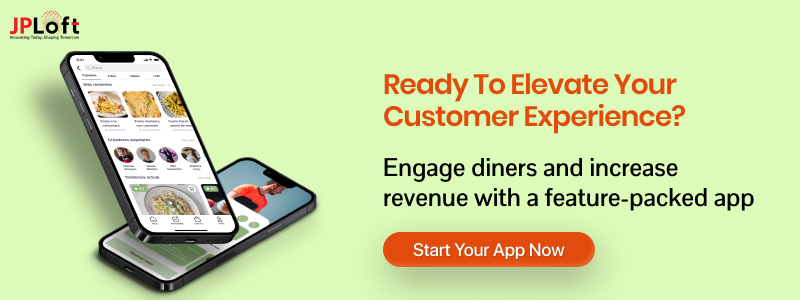
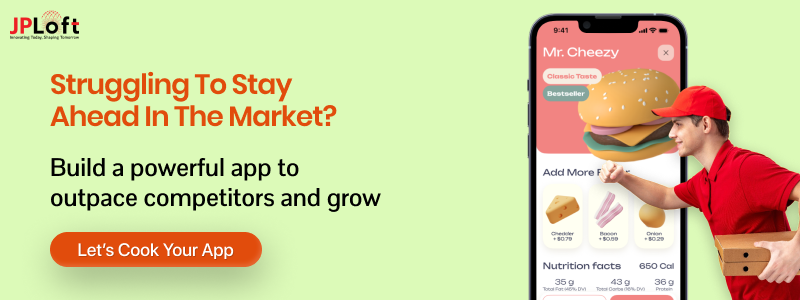
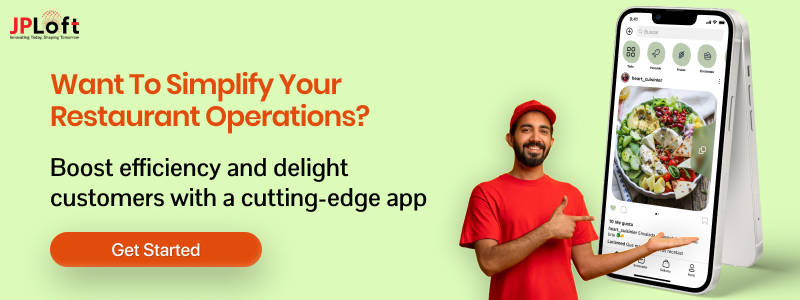

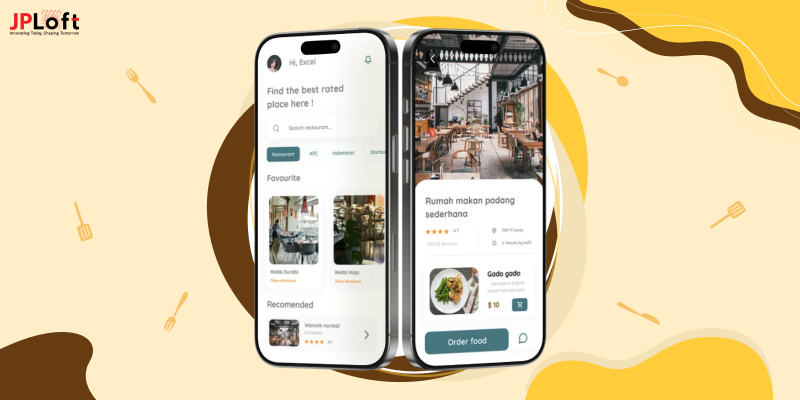
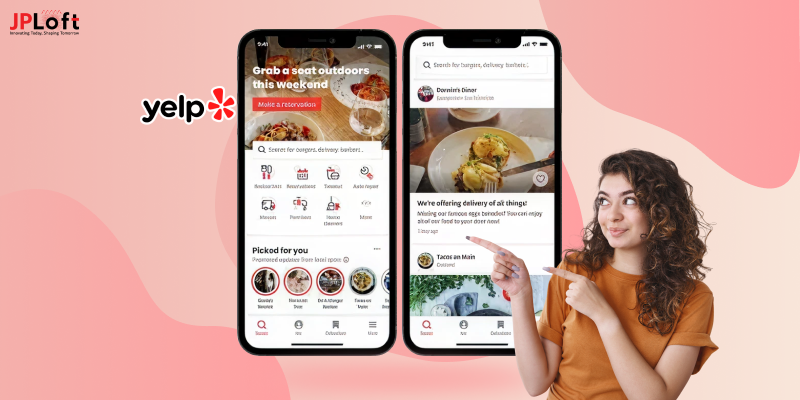
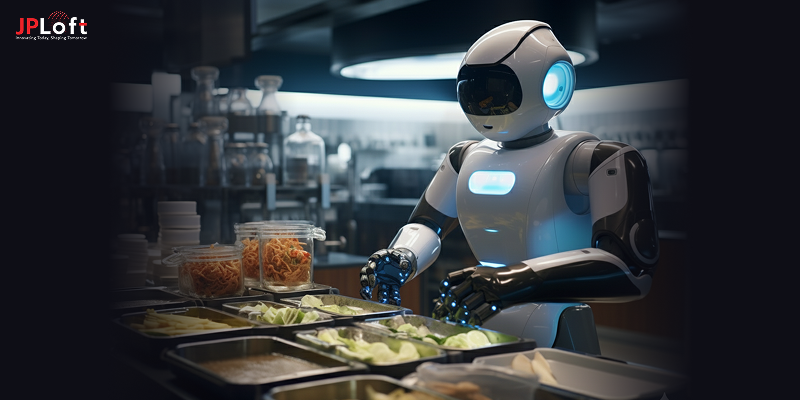


Share this blog